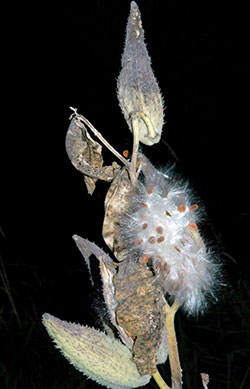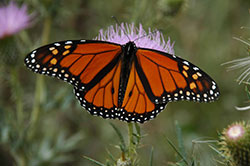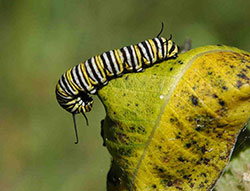Bill Ciesla
Colorado State University Extension Master Gardener in Larimer County
June 6, 2015

Milkweeds are fascinating plants. Over 100 species are native to North America. They are so named because of the milky sap in their stems, which consists of latex that contains alkaloids and several other compounds, which are toxic. Milkweeds produce seed pods known as follicles. The follicles ripen and split open in autumn, releasing the seeds. Each seed bears a cluster of white, silky filament-like hairs referred to as a coma. The seeds, each carried by its coma, are dispersed by the wind. Showy milkweed (Asclepias speciosa) is the common milkweed in our area. This is a tall, robust plant, typically found in meadows or along roadsides. It produces large clusters of purple flowers, which are attractive to moths, butterflies and other insects.
While milkweed flowers may be attractive to insects, their stems and leaves are not. Milkweed plants defend themselves by having leaves covered with fine hairs, which makes them undesirable to many foliage feeders. Most important, however, is their milky sap, which contains toxins and renders the leaves unpalatable. Despite these defenses, milkweed plants are a food source for a handful of insects, all of which are strikingly colorful. Their color patterns serve as a warning to natural enemies, telling them “I don’t taste good.”

Undoubtedly the best known of the insects that feed on milkweed is the monarch butterfly. It has orange wings edged with black, black wing veins and a black body. The larval stage, a caterpillar with white, yellow and black bands, feeds only on milkweed leaves. The larvae are able to metabolize the milkweed’s toxins and use them for their own defense. They render both the caterpillar and butterfly distasteful to would be predators. Monarch butterflies are perhaps best known for their annual migration. During September/October they begin an odyssey of several thousands of miles and fly south to spend the winter in fir forests in central Mexico or in groves of eucalypts on the California coast. During winter they cling by the thousands to tree branches. In March they head north and females lay eggs on milkweed plants along the way. Unfortunately Colorado is not part of the main route of these migrating butterflies and while I have seen the occasional monarch butterfly passing through, I have yet to see a caterpillar munching on a milkweed leaf in Colorado.

Sadly, the annual monarch migration is in trouble. In Mexico, illegal logging and bark beetle infestations have destroyed some of the forests where the butterflies spend the winter. Moreover, the forests have endured some cold winters. Extensive spraying of herbicides to control unwanted vegetation in agricultural areas has also killed many milkweed plants, significantly reducing the monarch’s food supply.

The demise of wild milkweed plants due to herbicides has caused Monarch Joint Venture, Live Monarch and other organizations engaged in monitoring and protecting monarch butterflies to encourage planting of milkweeds in gardens. While our native milkweed may be a bit overwhelming in a home garden, a species native to the eastern U.S., known as butterfly milkweed (Aescelpias tuberosa) is an attractive garden plant and does well in our area. It produces clusters of bright orange flowers and is attractive to many species of butterflies. Two years ago, a single plant appeared in one of my flower beds, the result of a wind borne seed. Last fall it produced abundant seeds. I collected some seeds and hope to get a few more plants started this year.
All photos by the author, Bill Ciesla.
The author has received training through Colorado State University Extension’s Master Gardener program and is a Master Gardener volunteer for Larimer County.
——————-
Larimer County is a county-based outreach of Colorado State University Extension providing information you can trust to deal with current issues in agriculture, horticulture, nutrition and food safety, 4-H, small acreage, money management and parenting. For more information about CSU Extension in Larimer County, call (970) 498-6000 or visit www.larimer.org/ext
——————-
Looking for additional gardening information? Check out the CSU Extension Horticulture Agent blog at www.csuhort.blogspot.com for timely updates about gardening around the state.
——————-
Visit PlantTalk Colorado ™ for fast answers to your gardening questions! www.planttalk.org PlantTalk is a cooperation between Colorado State University Extension, GreenCo and Denver Botanic Gardens.





